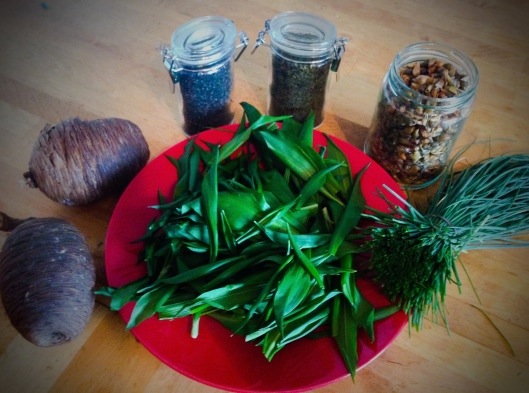One of the most underrated wild ingredients we have on hand I believe is the flower that many of our wild edibles offer ,
I’m not saying all flower are some great missing link between good food and great food in fact some flowers offer very little taste or indeed no taste at all but what they offer is something quite special it’s the difference between a non reactive plate of food and a plate of something that makes us smile , I see so many foragers filling up on edible fruits and greens but very few enjoying the finer pickings .
I’m not a believer in foraging to survive and part learning a skill to survive in a bad situation in fact I find the whole concept quite disturbing , surviving is in large mental it’s your self belief and I’m not talking about end of the world I’m talking about everyday and the ability to find a smile in a seemingly dreary day can make a huge difference ,
I more and more appreciate the small things that pass us by and cooking my foraged items has a massive feel good factor and the look on some people faces when they see a plate of wild food simply glowing is a great feeling .
So my plan is to give some advice on what flowers for what and I am going to do this in parts early spring,late spring , early summer,late summer and autumn as I don’t think there’s anything worse than reading about a great wild edible just to find it’s not in season so I’m including the ones on offer now .
I’m going to include my personal finding in regards to usability such as the flowers reaction to being cooked or if they are suitable for raw eating and again I’m no chef and certainly no expert and simply enjoy sharing my thoughts on my interests ,
Primrose (Primula vulgaris),
A pretty flower that has a slightly powdery texture , does not cook well and loses all colour and taste ,works well with sharp/tarte flavours
Violet. (Viola riviniana)
Defiantly a sweet /desert flower and a pretty garnish ,
It loses all consistency upon cooking and a little known fact is that it makes a great natural thickening agent for sauces or stews , also great a candied flowers .
Gorse (Ulex europaeus)
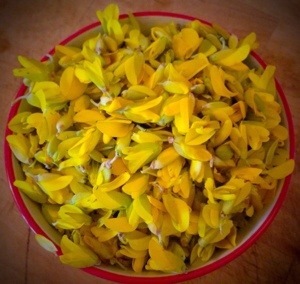
I think at one point or another most foragers have harvested gorse as it has so many uses from wine to syrup it has a mild coconut taste and is good cooked or uncooked a great addition to stir fry and candied make great decoration ( best picked after periods of sunshine)
Broom
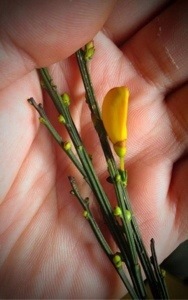
One of my favourites the flowers of broom taste like young pea shoots they lose some of the flavour with long cooking but in salads they are great not a garnish but a ingredient
Dandelion ( Taraxacum )
Dandelion is a multiple purpose item when young and still in bud they can be cooked and have a mildly mushroomy taste raw picked when young they are sweat and almost honey like but as they mature they become very bitter I find that after the flower has opened the petals need to be removed before eating .
Grape hyacinth (Muscari)

These little flowers are great boiled in sugar they are fragrant and a great garnish on sweets cooked they hold there shape and taste like sprouts , eaten raw they are bitter and crunchy and fit well with peppery and garlic
Ramsoms (Allium ursinum)
These need no introduction picked as a young bud these are the centre piece of many salad and hold together well in cooked dishes
Three cornered leak (Allium triquetrum)
These are similar in taste to ramsoms yet slightly milder and better used as a garnish ,
Chickweed (Stellaria media)

Purely a garnish yet if enough are picked it will make the best salad look like snow sprinkled upon it
The dead nettle family
Not great on availability but a great decorative addition to deserts a mix of red dead nettle yellow archangel and white dead nettle is a ridiculously pretty garnish , due to size they are not suitable in cooking
Apple blossom
An easily collected and a delicate floral flavour as a decoration on salads and sweets but in moderation as they contain cyanide , try from tree to tree for flavour as they change from sweet to sour , my favourite on salads are red flowers and on sweets white .
When cooked they change to a brown mush which is actually nice in moderation on strong flavoured meats .
Speedwells
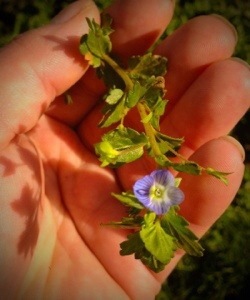
There are several speedwell varieties about at the minute some with bigger flowers than others nice as decoration only cooking is not suitable due to size ,
Common Daisy
Daisy’s are relatively neutral in taste but the small unopened buds pickled are great added to salads like capers I actually prefer them to the original my tip is to use a sweet vinegar ,
And do try them as it’s a great ingredient .
Lady’s smock (Cardamine pratensis)
Probably the real cuckoo as this little pretty white flower packs an amazing punch , it differs in strength from flower to flower but wow it’s a hot one even more so in my opinion than mustard , as a garnish on salads containing garlic or onions and is a great spicy flavouring in soups and stews ( the flower does not lose any flavour if dried well worth the effort )
Shepard’s purse ( Capsella bursa-pastoris)

Another great flavour with a real bite the flower is like a sharp additive something like sorrel has to be used fresh as it loses it’s taste with cooking
Lungwort ( Pulmonaria )
A bitter and tarte taste which is quite mild but the flowers need to be removed from any green parts of the plant as it is mucilaginous so the green bits make it unpleasant , turns to mush with cooking and does not retain any taste as a candied flower they are great .
Winter cress ( Barbarea vulgaris )

A very very mild mustard flower great for children’s salads giving a slight kick but not to much , not strong enough to retain taste in cooking
bitter cress (Cardamine hirsuta)
Just a decorative touch has a strong cress flavour as you would expect not good for cooking due to size but as the plants lose there appeal due to age the flower heads are a great replacement .
Coltsfoot ( Tussilago )
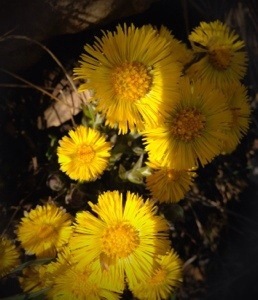
This is a strange plant the first bite is slightly aniseed in taste but that fades into a sweat taste unfortunately they lose any taste when cooked , also petals removed and sprinkled on sweats
Chamomile
I’m not going to comment on taste other than its pleasant I always taste an apple like taste but I’ve had so many conflicting tastes from people it’s a funny one , so apart from the normal use for tea it works well as a salad addition and petals on sweet foods
As I said I’m going to add to this list as the seasons allow and until then I will continue to smile on my dinner and hope some of you join me
-full” />


